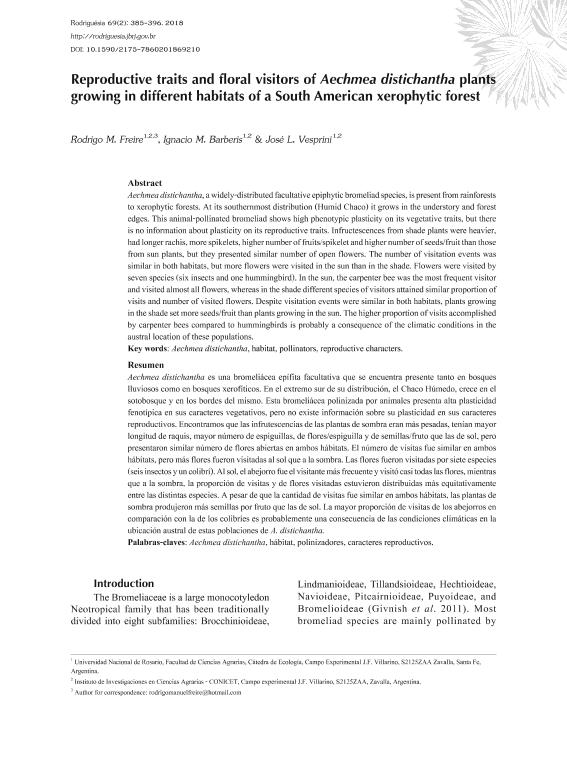Artículo
Aechmea distichantha es una bromeliácea epífita facultativa que se encuentra presente tanto en bosques lluviosos como en bosques xerofíticos. En el extremo sur de su distribución, el Chaco Húmedo, crece en el sotobosque y en los bordes del mismo. Esta bromeliácea polinizada por animales presenta alta plasticidade fenotípica en sus caracteres vegetativos, pero no existe información sobre su plasticidad en sus caracteres reproductivos. Encontramos que las infrutescencias de las plantas de sombra eran más pesadas, tenían mayor longitud de raquis, mayor número de espiguillas, de flores/espiguilla y de semillas/fruto que las de sol, pero presentaron similar número de flores abiertas en ambos hábitats. El número de visitas fue similar en ambos hábitats, pero más flores fueron visitadas al sol que a la sombra. Las flores fueron visitadas por siete espécies (seis insectos y un colibrí). Al sol, el abejorro fue el visitante más frecuente y visitó casi todas las flores, mientras que a la sombra, la proporción de visitas y de flores visitadas estuvieron distribuidas más equitativamente entre las distintas especies. A pesar de que la cantidad de visitas fue similar en ambos hábitats, las plantas de sombra produjeron más semillas por fruto que las de sol. La mayor proporción de visitas de los abejorros en comparación con la de los colibríes es probablemente una consecuencia de las condiciones climáticas en la ubicación austral de estas poblaciones de A. distichantha. Aechmea distichantha, a widely-distributed facultative epiphytic bromeliad species, is present from rainforests to xerophytic forests. At its southernmost distribution (Humid Chaco) it grows in the understory and forest edges. This animal-pollinated bromeliad shows high phenotypic plasticity on its vegetative traits, but there is no information about plasticity on its reproductive traits. Infructescences from shade plants were heavier, had longer rachis, more spikelets, higher number of fruits/spikelet and higher number of seeds/fruit than those from sun plants, but they presented similar number of open flowers. The number of visitation events was similar in both habitats, but more flowers were visited in the sun than in the shade. Flowers were visited by seven species (six insects and one hummingbird). In the sun, the carpenter bee was the most frequent visitor and visited almost all flowers, whereas in the shade different species of visitors attained similar proportion of visits and number of visited flowers. Despite visitation events were similar in both habitats, plants growing in the shade set more seeds/fruit than plants growing in the sun. The higher proportion of visits accomplished by carpenter bees compared to hummingbirds is probably a consequence of the climatic conditions in the austral location of these populations.
Reproductive traits and floral visitors of Aechmea distichantha plants growing in different habitats of a South American xerophytic forest
Fecha de publicación:
04/2018
Editorial:
Instituto de Pesquisas Jardim Botânico do Rio de Janeiro
Revista:
Rodriguésia
ISSN:
0370-6583
e-ISSN:
2175-7860
Idioma:
Inglés
Tipo de recurso:
Artículo publicado
Clasificación temática:
Resumen
Palabras clave:
AECHMEA DISTICHANTHA
,
HABITAT
,
POLLINATORS
,
REPRODUCTIVE CHARACTERS
Archivos asociados
Licencia
Identificadores
Colecciones
Articulos(IICAR)
Articulos de INST. DE INVESTIGACIONES EN CIENCIAS AGRARIAS DE ROSARIO
Articulos de INST. DE INVESTIGACIONES EN CIENCIAS AGRARIAS DE ROSARIO
Citación
Freire, Rodrigo Manuel; Barberis, Ignacio Martín; Vesprini, Jose Luis; Reproductive traits and floral visitors of Aechmea distichantha plants growing in different habitats of a South American xerophytic forest; Instituto de Pesquisas Jardim Botânico do Rio de Janeiro; Rodriguésia; 69; 2; 4-2018; 385-396
Compartir
Altmétricas




